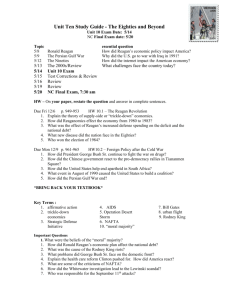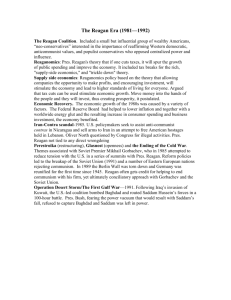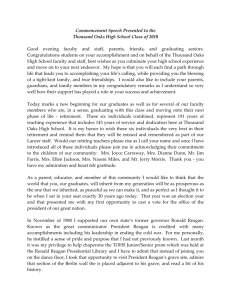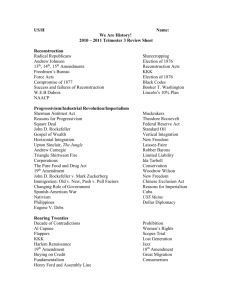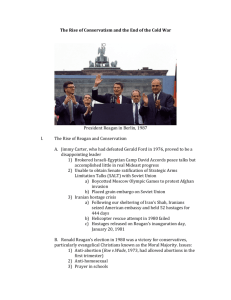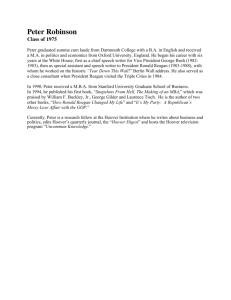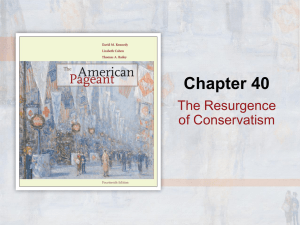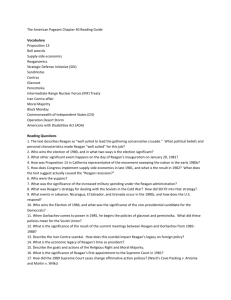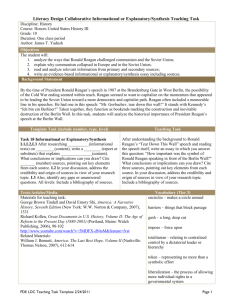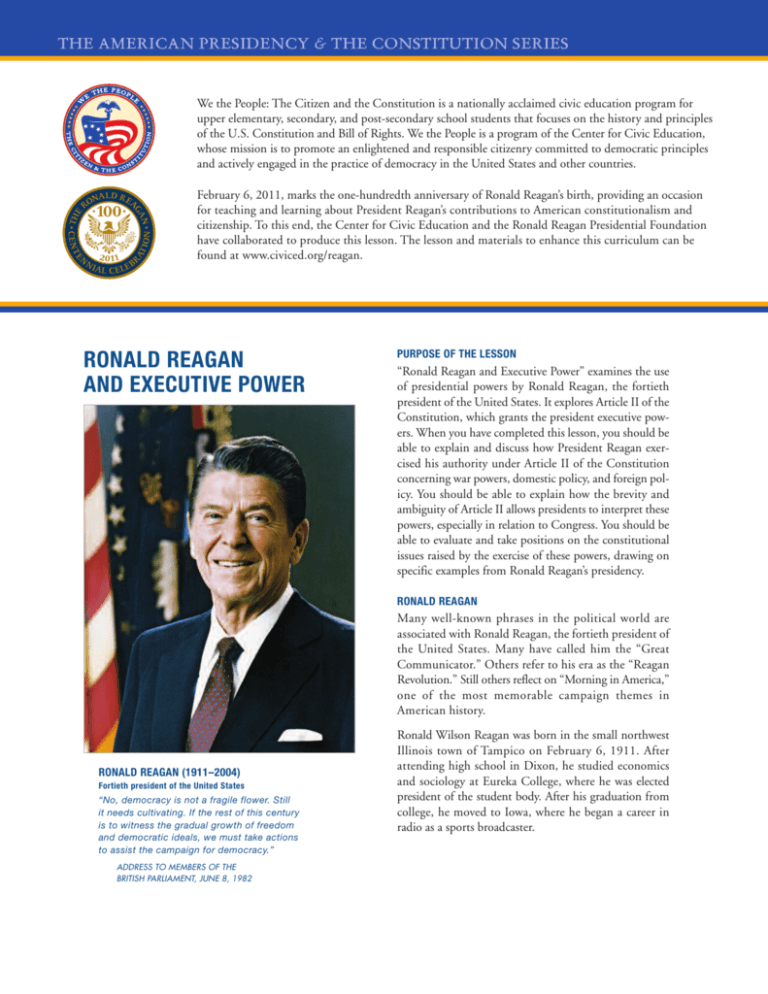
We the People: The Citizen and the Constitution is a nationally acclaimed civic education program for
upper elementary, secondary, and post-secondary school students that focuses on the history and principles
of the U.S. Constitution and Bill of Rights. We the People is a program of the Center for Civic Education,
whose mission is to promote an enlightened and responsible citizenry committed to democratic principles
and actively engaged in the practice of democracy in the United States and other countries.
February 6, 2011, marks the one-hundredth anniversary of Ronald Reagan’s birth, providing an occasion
for teaching and learning about President Reagan’s contributions to American constitutionalism and
citizenship. To this end, the Center for Civic Education and the Ronald Reagan Presidential Foundation
have collaborated to produce this lesson. The lesson and materials to enhance this curriculum can be
found at www.civiced.org/reagan.
RONALD REAGAN
AND EXECUTIVE POWER
PURPOSE OF THE LESSON
“Ronald Reagan and Executive Power” examines the use
of presidential powers by Ronald Reagan, the fortieth
president of the United States. It explores Article II of the
Constitution, which grants the president executive powers. When you have completed this lesson, you should be
able to explain and discuss how President Reagan exercised his authority under Article II of the Constitution
concerning war powers, domestic policy, and foreign policy. You should be able to explain how the brevity and
ambiguity of Article II allows presidents to interpret these
powers, especially in relation to Congress. You should be
able to evaluate and take positions on the constitutional
issues raised by the exercise of these powers, drawing on
specific examples from Ronald Reagan’s presidency.
RONALD REAGAN
Many well-known phrases in the political world are
associated with Ronald Reagan, the fortieth president of
the United States. Many have called him the “Great
Communicator.” Others refer to his era as the “Reagan
Revolution.” Still others reflect on “Morning in America,”
one of the most memorable campaign themes in
American history.
RONALD REAGAN (1911–2004)
Fortieth president of the United States
“No, democracy is not a fragile flower. Still
it needs cultivating. If the rest of this century
is to witness the gradual growth of freedom
and democratic ideals, we must take actions
to assist the campaign for democracy.”
ADDRESS TO MEMBERS OF THE
BRITISH PARLIAMENT, JUNE 8, 1982
Ronald Wilson Reagan was born in the small northwest
Illinois town of Tampico on February 6, 1911. After
attending high school in Dixon, he studied economics
and sociology at Eureka College, where he was elected
president of the student body. After his graduation from
college, he moved to Iowa, where he began a career in
radio as a sports broadcaster.
REAGAN EXECUTIVE POWER
▼
Although Ronald Reagan was a supporter of Democratic
president Franklin D. Roosevelt and maintained his
membership in the Democratic Party for many years, his
political beliefs became increasingly more conservative.
Part of Ronald Reagan’s decision to join the Republican
Party was its alignment with his anticommunist views. In
1963, he became involved in the campaign of Barry
Goldwater, the Republican nominee for president. In
October 1964, Ronald Reagan delivered a speech that
became known as “A Time for Choosing,” in which he
attacked the expansion of government and appeasement
of communism, themes that would resonate throughout
his career. The speech thrust him into the national
political spotlight.
What themes from Ronald Reagan’s time as a
spokesman for General Electric did he carry
over into his later career?
RONALD REAGAN
CENTENNIAL LESSON
While on assignment in California, Ronald Reagan took
a screen test and began working as an actor. He spent four
years in the U.S. Army Air Corps during World War II.
After completing his commitment to the army, he
returned to acting in motion pictures and began working
in television. Ronald Reagan appeared in a total of fiftythree films between 1937 and 1964.
2
While working in Hollywood, Ronald Reagan became
involved in the Screen Actors Guild, a labor union for
actors, and became its president in 1947. He served as its
president at a time when fears about the spread of communism led Congress and the FBI to investigate
members of the entertainment industry for their political
views. His experiences during this period of his life deeply
rooted his commitment to fighting communism both at
home and abroad.
In 1954, Ronald Reagan began hosting General Electric
Theater, a weekly television series. He became General
Electric’s spokesman, traveling to the company’s numerous plants across the country, speaking out against big
government, excessive taxation, and communism. During his General Electric years, Ronald Reagan honed his
message and polished his speaking skills.
Ronald Reagan was elected governor of California in
1966 and served two terms in office. While governor, he
became prominent in national Republican politics as well.
In 1976 he challenged incumbent president Gerald Ford
for the Republican nomination for president. Although
he did not win the nomination, he established his position as a leader within the Republican Party, emphasizing
the conservative ideals of less government regulation and
taxation, vigorous opposition to communism, and support for a strong national defense.
Ronald Reagan won the Republican nomination for president in 1980 and went on to defeat the incumbent Democratic president Jimmy Carter in the election. He was
sworn in as the fortieth president of the United States on
January 20, 1981, at the age of sixty-nine.
Some historians and political scientists have used the
phrase “The Age of Reagan” to describe his importance in
American politics. Ronald Reagan’s administration would
be defined by its efforts to reduce the size and scope of
government powers, reduce taxes, fight communism
around the world, and renew American patriotism. The
pursuit of these themes during Ronald Reagan’s presidency influenced the course of both domestic and foreign policy.
PRESIDENTIAL POWERS
The Framers of the Constitution were somewhat uncertain about creating the office of the presidency. They had
fought the Revolutionary War against the excesses of
executive tyranny and knew from history the dangers of
concentrating power in the hands of one person. But they
had also experienced problems due to the lack of a strong
executive under the Articles of Confederation. In creating
the presidency, they were inventing an executive unlike
any that had ever existed in a democratic republic—one
The Framers of the Constitution were aware that the
office and function of the executive would need to adapt
to the times and situations that the country would face
and would be shaped in part by those who occupied the
office. Although each president puts a unique stamp on
the presidency, he or she must act according to the constitutional definition and limits of the executive and the
precedents of those who had previously served.
Upon reading Article II of the Constitution, one is struck
by how brief the article is, considering how important the
office it creates has become. The Constitution provides
only minimal guidance as to what the president is
expected to do or exactly how the president may exercise
his or her powers. For example, the president is directed
to “from time to time give to the Congress Information
on the State of the Union, and recommend to their
Consideration [certain] Measures.” It is unclear exactly
what the president’s involvement with the legislative
process should be, and this involvement has changed
over time.
Each president must abide by the Constitution as both
the source of presidential authority and a limitation of
that authority. In Article II, the president is given some
specific powers. Some of these powers are fairly clear and
easy to apply. The president, for example, is given the
power to veto legislation passed by Congress. But some of
the president’s powers are less clear and more subject to
diverse interpretations. The president is “vested” with the
executive power and is charged with the responsibility to
“take Care that the Laws be faithfully executed.” In the
context of the pressing issues of the day, presidents have
sometimes differed in their interpretation and application of these phrases.
The Constitution states that “the President shall be Commander in Chief of the Army and Navy.” Throughout
history, this power of the president has been especially
subject to interpretation. The extent of the president’s
authority over the military is unclear. Article I of the
Constitution gives Congress the power to declare war, to
raise and support military forces, and to raise and appropriate funds for those forces. As James Wilson stated at the
Pennsylvania Ratifying Convention, the Constitution was
designed to “prevent one man from hurrying us into war.”
▼
strong enough to be effective, but not so strong as to become oppressive. The result of their deliberations and attempts to strike this balance is found in Article II of the
U.S. Constitution, which provides the basic structure of
this office and a fairly brief list of its designated powers.
How did Ronald Reagan rise to national
prominence as a politician? What issues
were important to him during his early
career and as president?
In Federalist 69, Alexander Hamilton drew a distinction
between the powers of the president under the Constitution and the powers of the King of England:
The President is to be commander-in-chief of
the army and navy of the United States. In this
respect his authority would be nominally the
same with that of the king of Great Britain, but
in substance much inferior to it. It would
amount to nothing more than the supreme
command and direction of the military and
naval forces, as first General and admiral of the
Confederacy; while that of the British king extends to the declaring of war and to the raising
and regulating of fleets and armies—all which,
by the Constitution under consideration, would
appertain to the legislature.
Of course, presidents and congresses have debated the
distribution of powers when applied to actual situations.
The relative powers and responsibilities of the two
branches are particularly difficult to judge when Congress
has not declared war. Most of the military engagements
of the United States have never been formally declared by
Congress. Presidents have on many occasions committed
troops to battle without a declaration of war from Congress.
After the Vietnam War, many members of Congress felt
that it was time to clear up some of the ambiguities in
the Constitution about the commitment of U.S. troops.
In the War Powers Resolution of 1973, Congress sought
a balance of congressional and presidential powers in
making decisions about sending troops to war. The War
Powers Resolution stated that without authorization or a
declaration of war by Congress, “the President in every
3
REAGAN EXECUTIVE POWER
▼
office that some felt had expanded or grown too powerful. The Watergate scandal of Richard Nixon’s presidency
reaffirmed this belief.
What constitutional principles were embodied
in President Reagan’s first inaugural address?
possible instance shall consult with Congress before introducing United States Armed Forces into hostilities.”
But the resolution recognizes that serious and immediate
threats may require swift action, and consultations may
cause too much delay. In such cases, after dispatching
troops, the president is required to report to Congress,
and Congress determines whether the troops should remain or be removed from the situation.
Presidents since Richard Nixon have maintained that
the War Powers Resolution is unconstitutional because
they claim it conflicts with the president’s authority as
commander in chief. On the other hand, some scholars
have claimed that the War Powers Resolution is an
unconstitutional delegation of congressional power to
the president.
RONALD REAGAN
CENTENNIAL LESSON
EXECUTIVE POWER AND THE CONTEMPORARY PRESIDENCY
4
Every presidency begins against the backdrop of current
events. In the decades prior to Ronald Reagan’s inauguration, the country had experienced the expansion of
presidential powers during the administrations of
Lyndon Johnson (1963–1969) and Richard Nixon
(1969–1974), and then the contraction of presidential
influence under the presidencies of Gerald Ford (1974–
1977) and Jimmy Carter (1977–1981).
During the 1960s and 1970s, policymaking centered in
the executive branch resulted in concerns that the power
of the presidency had grown too large and that certain
actions of the presidents were unconstitutional. A prime
example of presidential strength was the direction of the
war in Vietnam, which has been described as a “presidential war,” over which Congress had little influence.
The term imperial presidency has been used to describe an
Upon the resignation of President Nixon, his vice president, Gerald Ford, assumed the office of president. Congress, in reaction to recent events, was committed to
asserting its constitutional power in relationship to the
powers of the president. When Jimmy Carter was elected
president in 1976, Congress asserted itself further. Some
scholars have referred to the administrations of Presidents
Ford and Carter as the imperiled presidency. The Constitution’s lack of a detailed explication of the formal powers of the presidency had enabled Presidents Johnson and
Nixon to expand their powers. That same lack of specificity enabled Congress to attempt to restrict the powers
of the presidency during the administrations of Presidents
Ford and Carter.
In his first inaugural address, President Reagan expressed
his optimistic view that the problems of the nation could
be overcome with conservative policies. At the heart of
his economic plan was the concept that “government is
not the solution to our problem; government is the problem.” He explained this by saying,
We are a nation that has a government—not the
other way around. And this makes us special
among the nations of the Earth. Our government has no power except that granted it by the
people. It is time to check and reverse the
growth of government, which shows signs of
having grown beyond the consent of the governed. It is my intention to curb the size and influence of the Federal establishment and to
demand recognition of the distinction between
the powers granted to the Federal Government
and those reserved to the States or to the people.
Although it is difficult to select a few isolated actions to
be representative, presidential dealings can be divided
into war powers, domestic politics, and foreign relations.
We will examine Ronald Reagan’s use of presidential
power during his administration as it relates to each of
these categories.
PRESIDENT REAGAN AS COMMANDER IN CHIEF
One short military engagement illustrates Ronald Reagan
as commander in chief. President Reagan’s administration
was concerned about Soviet and Cuban influence in
Central America and the Caribbean. On the small
Caribbean island nation of Grenada, a pro-Soviet
▼
President Reagan’s position was that as commander in
chief he had an obligation to ensure national security and
protect the interests of the country and its citizens. As for
the War Powers Resolution, President Reagan reported to
Congress, but only consistent with, not under the War
Powers Resolution. He stated that he was acting under
his constitutional authority to swiftly commit troops.
Subsequent presidents have also used this distinction
when reporting to Congress concerning troop deployment and have not sought formal consultation with Congress before committing troops.
How did President Reagan justify his constitutional
authority to invade Grenada? Do you think the
president had the authority to commit troops
without congressional approval? Explain why
or why not.
communist government with close ties to communist
Cuba seized power in 1979 and was proceeding with
construction of a large airfield. President Reagan believed
it would be used by the Soviets and Cuba to supply
communist groups in Central America.
In October 1983, the government of Grenada was overthrown and the island’s military assumed control. In response, President Reagan ordered American troops to
invade. Several other Caribbean nations also sent troops.
The invasion, conducted as a rescue mission, ensured the
safety of about a thousand Americans on the island.
The invasion of Grenada is often cited as an example of
President Reagan’s decisiveness and action against the expansion of communism. Although there was some controversy over this exercise of presidential power, the
invasion denied communism another foothold in the
Caribbean and restored Grenada’s parliamentary government, which continues to hold free elections. The Grenada
invasion is also regarded as a return to the vigorous exercise
of war powers by the president.
DOMESTIC POLICY:
THE AIR-TRAFFIC CONTROLLERS’ STRIKE
A president can clearly point to the commander in chief
clause of the Constitution as a basis for his or her authority to deploy troops. However, many other actions
that presidents take consist of a combination of powers
derived from various constitutional clauses and an interpretation and application of these powers to particular
situations. Actions taken in domestic policy are often a
mix of powers.
The constitutional division of war powers between the
president and Congress has been debated since the Constitutional Convention. History provides us with many
examples of presidents committing troops without either
a declaration of war or prior congressional approval. But
the War Powers Resolution of 1973 required presidents to
consult with Congress before committing troops, except
in cases of serious and immediate threats. In the case of
Grenada, Ronald Reagan’s administration informed some
congressional leaders but did not seek actual approval or
advice before the invasion.
▼
The mission achieved success quickly. The Americans on
the island were evacuated to the United States, procommunist forces—largely Cuban troops—were defeated,
and a new civilian government was formed. Even so, the
invasion raised some of the same questions regarding
executive authority that had been raised during the
Vietnam War a decade earlier with previous presidents.
What issues did President Reagan have to consider
when he made his decision to fire the striking
air-traffic controllers? Do you think he made the
right decision? Explain why or why not.
5
REAGAN EXECUTIVE POWER
The president is charged with the general responsibility to
“take Care that the Laws be faithfully executed.” The
Constitution notes that “the executive power shall be
vested in a President of the United States of America.”
Of course, the legislature is given specific powers of its
own, such as the power to create laws and appropriate
money. However, the Framers were vague on how
domestic policy would be administered by the president.
RONALD REAGAN
CENTENNIAL LESSON
Early in President Reagan’s administration, the nation’s
air-traffic controllers went on strike, seeking higher
salaries and fewer working hours. The controllers were
employees of the federal government and their strike
violated federal law, which prohibited federal workers
from striking. Although the controllers’ union and several other unions had called similar strikes under previous
presidents, no action had been taken against them. With
the controllers on strike, the nation’s air travel was briefly
crippled and millions of Americans were adversely affected. President Reagan announced that the striking controllers must return to their jobs within 48 hours or they
would be fired. When most of the workers did not return
to work, he kept his promise and fired more than eleven
thousand air-traffic controllers, replacing them with military controllers, supervisors, and nonstriking workers.
President Reagan banned the striking workers from being
rehired. The Justice Department pursued fines against the
union. Within months, the union was decertified and was
effectively broken.
6
THE PRESIDENT AND FOREIGN POLICY
One important role of any president is that of “chief
diplomat.” Although these specific words do not appear
in the Constitution, the president is given the authority
to receive foreign diplomats. The president also acts as
the director of foreign policy by appointing the secretary
of state and ambassadors to foreign countries. These powers are shared with the Senate, which has the authority to
confirm presidential appointments to these offices and to
advise on and consent to treaties made by the president.
In practice, the presidency has gained many informal foreign policy powers not written directly into the Constitution. The ability of the president to react swiftly, to
speak as a single voice—in contrast to the many voices in
Congress—and the central position of the president in
American politics have created a dominant role for the
president in foreign policy making. As international travel
has become easier, presidents have capitalized on the
opportunity to personally conduct diplomatic meetings
with heads of state around the world.
Limiting the expansion of the Soviet Union’s influence
became one of the main goals of U.S. foreign policy after
World War II. The struggle between liberal democracy,
led by the United States, and totalitarian communism,
primarily represented by the Soviet Union, was called the
Cold War. To challenge each other’s influence, both the
United States and the Soviet Union built up their militaries and arms stockpiles and extended them to their
respective allies during this period.
President Reagan’s action in firing the striking workers
was controversial. The strike and subsequent firing of
these workers resulted in cutting roughly half the scheduled commercial flights on the first day of the strike, and
the airline industry lost substantial revenue. Firing the
workers went against the precedents of the four previous
presidents, who did not fire government workers in similar situations. The Federal Aviation Administration faced
the need to immediately hire and train new controllers.
Commercial flights recovered quickly, however. The airtraffic control system continued to function. Most Americans supported President Reagan’s actions. Internationally,
the Soviets paid close attention to this incident and were
struck by President Reagan’s resolve and decisiveness.
Convinced that the previously weakened U.S. military forces only invited Soviet expansionism around the
globe, Ronald Reagan promoted strengthening the U.S.
military through increased defense spending as one of the
major themes of his 1980 presidential campaign. Military spending had been declining since the end of the Vietnam War—resulting in shortages of military parts and
equipment—and had begun increasing at the end of President Carter’s administration. Furthermore, President
Reagan and his advisors believed that because the Soviets were outspending the United States in military
weapons procurement, a potentially dangerous imbalance of power could develop.
Some critics claimed that the firing seemed to contradict
President Reagan’s campaign promises to the air-traffic
controllers’ union, the only union to have supported his
election campaign. His decision to fire the striking
workers showed that President Reagan did not intend
his view of limited government to mean that he favored
a weakened presidency.
President Reagan also aimed to reduce the influence of
the Soviet Union and “roll back” or eliminate communist regimes around the globe by supporting anti-Soviet
governments and groups. These included the mujahideen
in Afghanistan, the Contras in Nicaragua, and the Solidarity Movement’s struggle for freedom in Poland. This
policy became known as the “Reagan Doctrine.”
▼
Also in this speech, President Reagan called for a lessening of the arms race between the United States and the
Soviet Union. Just six months later, the two leaders signed
a treaty to reduce nuclear weapons.
How did Ronald Reagan and Mikhail Gorbachev
contribute to ending the Cold War?
President Reagan was very vocal in his opposition to communism. He predicted that communism would be left
“on the ash heap of history” with other “tyrannies which
stifle the freedom and muzzle the self-expression of the
people.” He referred to the Soviet Union as an “evil
empire.” This dramatic statement and President Reagan’s
policies toward the Soviet Union generated a great deal of
controversy. Some saw his words as an important reassertion of American resolve. Others worried that they needlessly antagonized the Soviets and increased the risk of
war. To alleviate these concerns, the president spoke of
his program as “peace through strength.”
Early in President Reagan’s second term, a reform-minded
leader, Mikhail Gorbachev, assumed power in the Soviet
Union. Like previous presidents, Ronald Reagan made
plans to meet the new Soviet leader. During his presidency, President Reagan met with General Secretary
Gorbachev on five occasions from 1985 to 1988. The
two leaders developed a personal relationship and worked
together to reduce the tensions of the Cold War.
In June 1987, President Reagan stood before the famous
Brandenburg Gate, which had been blocked by the Berlin
Wall. The wall had been constructed in 1961 by communist East Germany to isolate West Berlin and to prevent
East Germans from fleeing to the West. It had become a
symbol of communist repression around the world. In what
would become one of his most famous speeches, President
Reagan challenged Secretary Gorbachev and said,
General Secretary Gorbachev, if you seek peace,
if you seek prosperity for the Soviet Union and
Eastern Europe, if you seek liberalization, come
here to this gate. Mr. Gorbachev, open this gate!
Mr. Gorbachev, tear down this wall!
Mikhail Gorbachev introduced sweeping reforms to the
Soviet Union that gave his people a greater measure of
political and economic freedom. He hoped this would
strengthen the weak Soviet economy and improve citizens’ well-being. The reforms, however, unleashed a wave
of protests. The protest movements led to the collapse of
communism all over Central and Eastern Europe. On
November 9, 1989, the Berlin Wall was opened and eventually dismantled. The destruction of the wall became a
symbol of this historic turning point. In 1991, the Soviet
Union was dissolved and Mikhail Gorbachev resigned.
President Reagan’s “peace through strength” strategy has
often been credited as contributing to the collapse of the
Soviet Union and the end of the Cold War. President
Reagan himself believed that when given the choice, people will always choose freedom.
RONALD REAGAN AND THE PRESIDENCY
President Reagan’s reassertion of presidential power left a
significant mark on events of the 1980s and reinvigorated
the office of the presidency. It is generally acknowledged
that President Reagan’s policies were key factors leading to
the collapse of the Soviet Union and the end of the Cold
War, liberating millions. President Reagan proved flexible
in his dealings with the Soviet Union, reducing tensions
and negotiating a reduction in arms. However, opponents
thought that President Reagan’s policies of strengthening
the American military and confronting the Soviet Union
would increase the danger of armed conflict while adding
to the budget deficit. In some instances, these policies led
to claims that the United States had supported governments and outside groups that at times disregarded
human rights. Nevertheless, during his eight years in
office, Ronald Reagan’s political instincts and determination
to spread democracy and freedom raised American
morale and promoted liberty around the world. Although
scholars continue to debate the merits of his policies,
popular esteem for Ronald Reagan has risen over time. Public opinion polls indicate that he remains one of the country’s most popular and admired presidents.
7
REAGAN EXECUTIVE POWER
REVIEWING AND USING THE LESSON
RONALD REAGAN
CENTENNIAL LESSON
What powers related to waging war are given to
Congress under Article I? What powers are granted
to the president under Article II? Why are there conflicts in this division of power between the president
and Congress as they relate to war powers?
Why do you think members of Congress thought
they needed to pass the War Powers Resolution?
Why have presidents asserted that the War Powers
Resolution is unconstitutional? Do you agree with
the position of Congress in 1973 or the position
of subsequent presidents? Why or why not?
How do the terms imperial presidency and imperiled presidency reflect the fears of the Framers of the
Constitution? How do the presidential leadership
styles of Presidents Nixon and Johnson compare to
the leadership styles of Presidents Ford and Carter?
What constitutional principles concerning the
powers of the federal government did President
Reagan describe in his first inaugural address?
What founding philosophical principles does
President Reagan echo in this passage?
Discuss President Reagan’s actions in Grenada with
reference to the Constitution and the War Powers
Resolution. Did the president act within his constitutional powers? Did he act within the boundaries
of the War Powers Resolution? Why or why not?
What parts of the Constitution did President
Reagan rely on in his firing of the air-traffic controllers? Do you see a conflict in President Reagan’s
actions in this case and his goal of limiting the
power of the government? Why or why not?
Do you see a conflict between the goals of limiting
the power and size of the federal government and
the expansion of the military? Why or why not?
CRITICAL THINKING EXERCISES
Critical thinking exercises for this lesson can be found at
www.civiced.org/reagan. These exercises develop intellectual
and participatory skills and offer an opportunity to assess
students’ capacity to develop and defend an argument
and to support it with evidence.
WEBSITES
www.civiced.org/reagan
Visit www.civiced.org/reagan to access a full spectrum of
resources that will enrich your study of Ronald Reagan and the
Constitution. Resources include critical thinking exercises, a
timeline, a biography of Reagan, frequently asked questions on
President Reagan’s administration, links to websites related to
the president, and a helpful list of additional readings.
www.reaganfoundation.org
The Ronald Reagan Presidential Foundation is the sole nonprofit, nonpartisan organization dedicated to the preservation
and promotion of the legacy of Ronald Reagan and his timeless
principles of individual liberty, economic opportunity, global
democracy, and national pride.
www.reagancentennial.com
The Ronald Reagan Centennial Celebration is a historic, yearlong celebration to commemorate the one-hundredth anniversary of Ronald Reagan’s birth on February 6, 2011. The Ronald
Reagan Presidential Foundation has planned a worldwide Centennial Celebration to pay tribute to the legacy of the fortieth
president through public outreach and education.
www.ReaganLibrary.gov
Administered by the National Archives and Records Administration, the Ronald Reagan Presidential Library & Museum has
served thousands of researchers and millions of visitors since its
opening in 1991.
CREDITS
© 2011, Center for Civic Education. All rights reserved. Permission is
granted to freely reproduce and use this lesson for nonprofit, educational
purposes. Copyright must be acknowledged on all copies. Images used in
this lesson may be subject to copyright restrictions and may not be reproduced without prior written permission from the copyright holder. Please
visit the Center for Civic Education’s website at www.civiced.org.
This supplemental lesson commemorating the centennial of Ronald
Reagan’s birth was made possible by a grant from The J. Willard and Alice
S. Marriott Foundation.
Images were provided by the Ronald Reagan Presidential Library &
Museum, the Department of Defense, and Getty Images (page 5).
This supplemental lesson on Ronald Reagan was authored by Lauri
McNown, who teaches in the Department of Political Science at the
University of Colorado at Boulder.
Ronald Reagan Centennial Celebration
Center for Civic Education
We the People: The Citizen and the Constitution
8

